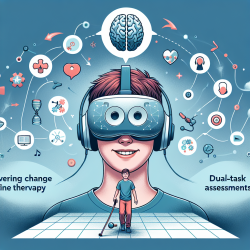Introduction
Concussions are complex brain injuries that can have a wide array of effects on cognition, balance, and overall neurological function. For practitioners working with children, particularly in educational settings, understanding and managing these injuries is crucial. Recent research, including the narrative review "Using concurrent gait and cognitive assessments to identify impairments after concussion," highlights the importance of dual-task assessments in identifying subtle impairments that may not be evident through traditional testing methods.
The Power of Dual-Task Assessments
Dual-task assessments involve the simultaneous evaluation of cognitive and motor functions, such as gait, to detect impairments. This approach is particularly beneficial in concussion management, as it can reveal deficits that single-task assessments might miss. The integration of cognitive tasks with gait analysis allows for a more comprehensive understanding of an individual's recovery status.
Implementing Dual-Task Assessments in Practice
For speech-language pathologists and other practitioners, incorporating dual-task assessments into concussion management protocols can enhance the accuracy of evaluations. Here are some practical steps to consider:
- Training and Education: Ensure that all team members are trained in administering and interpreting dual-task assessments. This might involve workshops or continuing education courses focused on the latest research and techniques.
- Collaboration: Work closely with other healthcare professionals, such as physical therapists and neuropsychologists, to integrate dual-task assessments into a multidisciplinary approach to concussion management.
- Data-Driven Decisions: Use the data collected from dual-task assessments to make informed decisions about a child's readiness to return to school or sports. This data can also help in tailoring individualized rehabilitation plans.
Encouraging Further Research
While dual-task assessments are promising, further research is needed to refine these methods and establish standardized protocols. Practitioners are encouraged to contribute to this body of research by documenting outcomes and sharing findings with the broader medical community. This collaborative effort can lead to the development of more effective concussion management strategies.
Conclusion
By embracing dual-task assessments, practitioners can improve their ability to identify and manage concussion-related impairments. This approach not only enhances clinical decision-making but also supports better outcomes for children recovering from concussions. As we continue to learn and innovate, the potential for improving the lives of those affected by concussions grows exponentially.
To read the original research paper, please follow this link: Using concurrent gait and cognitive assessments to identify impairments after concussion: a narrative review.










